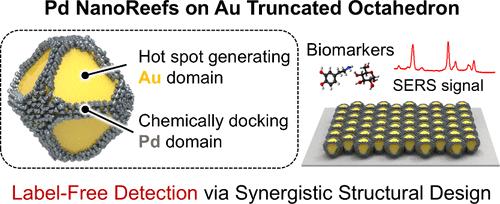钯纳米探针在金截断八面体纳米探针上的表面增强拉曼散射检测无标记生物分子
IF 16
1区 材料科学
Q1 CHEMISTRY, MULTIDISCIPLINARY
引用次数: 0
摘要
表面增强拉曼光谱(SERS)能够实现超灵敏的分子检测,但在应用于氨基酸和碳水化合物等生物相关分子时面临重大挑战,因为它们的表面吸附弱,拉曼截面低,导致信号再现性差。为了解决这些限制,我们提出了一种形态工程的杂化纳米结构,称为Au截断八面体上的Pd纳米体(Au - Pd NRTO),它结合了Au的强等离子体特性和Pd对含氧生物分子的高结合亲和力。在这种结构中,Pd选择性地在Au表面的高能位置生长成珊瑚状柱状柱,正是在电磁场增强最大化的位置,显著改善了SERS信号。通过调整Pd生长的程度,我们实现了保持等离子体活性和增强分子吸附之间的最佳平衡。有限元模拟和实验SERS数据证实,中间Pd覆盖通过耦合有效的近场增强和有效的分析物捕获,获得了最佳的传感性能。利用该平台,我们成功地进行了小生物分子的无标记检测,包括神经递质、单糖和氨基酸,具有高灵敏度和多路复用能力。这些发现证明了一种开发多功能等离子体传感器的形态学驱动策略,强调了将化学相互作用位点直接嵌入sers活性区域以最大化检测效率的重要性。本文章由计算机程序翻译,如有差异,请以英文原文为准。

Pd Nanoreefs on Au Truncated Octahedra Nanoprobes for Label-Free Biomolecule Detection via Surface-Enhanced Raman Scattering
Surface-enhanced Raman spectroscopy (SERS) enables ultrasensitive molecular detection but faces significant challenges when applied to biologically relevant molecules, such as amino acids and carbohydrates, due to their weak surface adsorption and low Raman cross sections, which lead to poor signal reproducibility. To address these limitations, we present morphology-engineered hybrid nanostructures, termed Pd nanoreef on Au truncated octahedron (Au–Pd NRTO), which combine the strong plasmonic properties of Au with the high binding affinity of Pd for oxygen-containing biomolecules. In this architecture, Pd selectively grows into coral-like columnar pillars at high-energy sites on the Au surface, precisely where electromagnetic field enhancement is maximized, significantly improving SERS signals. By tuning the extent of Pd growth, we achieve an optimal balance between preserving plasmonic activity and enhancing molecular adsorption. Finite element simulations, corroborated by experimental SERS data, reveal that intermediate Pd coverage yields the best sensing performance by coupling efficient near-field enhancement with effective analyte capture. Using this platform, we successfully performed label-free detection of small biomolecules, including neurotransmitters, monosaccharides, and amino acids, with high sensitivity and demonstrated multiplexing capability. These findings demonstrate a morphology-driven strategy for developing multifunctional plasmonic sensors, underscoring the importance of embedding chemically interactive sites directly within SERS-active regions to maximize detection efficiency.
求助全文
通过发布文献求助,成功后即可免费获取论文全文。
去求助
来源期刊

ACS Nano
工程技术-材料科学:综合
CiteScore
26.00
自引率
4.10%
发文量
1627
审稿时长
1.7 months
期刊介绍:
ACS Nano, published monthly, serves as an international forum for comprehensive articles on nanoscience and nanotechnology research at the intersections of chemistry, biology, materials science, physics, and engineering. The journal fosters communication among scientists in these communities, facilitating collaboration, new research opportunities, and advancements through discoveries. ACS Nano covers synthesis, assembly, characterization, theory, and simulation of nanostructures, nanobiotechnology, nanofabrication, methods and tools for nanoscience and nanotechnology, and self- and directed-assembly. Alongside original research articles, it offers thorough reviews, perspectives on cutting-edge research, and discussions envisioning the future of nanoscience and nanotechnology.
 求助内容:
求助内容: 应助结果提醒方式:
应助结果提醒方式:


